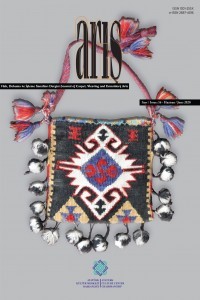
Arış Dergisi
Yazarlar: ["Aysen SOYSALDI", "Recep KARADAĞ", "Emine TORGAN GÜZEL"]
Konular:-
DOI:10.32704/akmbaris.2023.178
Anahtar Kelimeler:El Dokuma,Uşak Halıları,Ayaş,Doğal Boya,Boyarmadde Analizi
Özet: Ayaş is one of the most important Muslim Turkish locations in central Anatolia in the province of Ankara the period of Ottoman. Historians point out that it was a highly developed, crowded city with a Muslim population in the fifteenth and sixteenth centuries. A study was carried out on the rugs of mosque in the central towns of Ayaş in 1997. A group of carpets that were found important in this research was presented at the symposium held in Ayaş in the same year and printed in full text. Uşak carpets, which are mentioned in the same study and which are the subject of this study with their dyestuffs, were found in Şeyh Muhyiddin Mosque in the bazaar of Ayaş and Bünyamin Ayaşi Mosque in the upper street. These mosques were built in the sixteenth century. Both mosques which were named after the saints they were buried in. The mosques are in the city being the heart of socio-economical and cultural life and were built in the 16th century. One of the carpets is known as Uşak medallion design, found in Şeyh Muhyiddin Mosque. It is likely to date 16th century in Museum of Turkish and Islamic art. This carpet as a whole is similar to the medallion Uşak, late 16th century private collection, New York. Although there are different motives in the borders of other carpets, the ground has an Uşak type hatayi (peony) design. These carpets are designed unit report is repeated, in full symmetry, depending on the infinity principle. The color features of the carpets are similar to each other red, blue, yellow, white, and brown. The pile/knot yarn samples taken during the research from the very worn, dismantled edges of four Uşak carpets were stored in separate envelopes. In the TCF-DATU-Cultural Heritage Preservation and Natural Dyes Laboratory, dyestuff analyses of the yarn samples belonging to these historical carpets were made and important findings were reached. It was determined that all of the dyestuffs were natural dyes, especially madder (Rubia tinctorum L.) and woad (Isatis tinctoria L.) or indigo plant (Indigofera tinctoria L.) were used. Some of these carpet fragments found in Bünyamin Ayaşi Mosque are now under protection at the Foundation Artifacts Museum in Ankara. However, Ayaş Mufti and Ankara Foundation Artifacts Museum Directorate in correspondence could not find a record of the medallion carpet and the others.